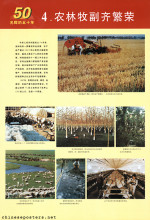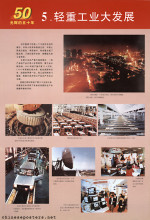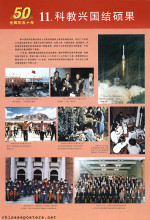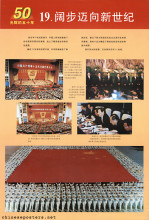
"Fifty Glorious Years 1949-1999" (光辉的五十年1949-1999), designed by the Museum of the Chinese Revolution (中国革命博物馆) and published by the Zhongguo funü chubanshe (中国妇女出版社) and the Zhongguo dabaike quanshu chubanshe (中国大百科全书出版社) in 1999, is a series of 20 posters devoted to the period 1949-1999.
The developments that occurred after the adoption of Deng Xiaoping's strategy of Reform and Opening Up (改革开放) in 1978 receive more attention than the events preceding 1978. In that sense, the series celebrates the successes of Deng's actions. Jiang Zemin, Deng's successor, takes the credit for these successes as well.
The title reads "8. Trade and tourism flourish together" (8. 贸易旅游共兴旺).
The text reads "Since the founding of the PRC, domestic and foreign trade has developed significantly. After the reform and opening up, under the guidance of the policy of invigorating the domestic economy and opening up to the outside world, urban and rural trade has become increasingly prosperous, not only meeting the people's living needs, but also becoming an important source of finance for our country.
Our country has established trade relations with more than 180 countries and regions in the world, and China's foreign trade has ranked among the top ten in the world for the first time. Foreign economic and technological cooperation and foreign investment continue to increase, and there are nearly 320,000 foreign investment enterprises, making it the developing country that absorbs the most foreign investment.
With the reform and opening up, the tourism industry has developed rapidly, with more than 600 million domestic tourists and more than 50 million inbound tourists each year. In 1996, the total tourism revenue reached 247.8 billion yuan. The development of the tourism industry has not only expanded employment opportunities, but also promoted and driven the development of related industries, enabling some old, young, border and poor areas to embark on the road of poverty alleviation and prosperity." (中华人民共和国成立以来,国内外贸易得到较大发展。改革开放以后,在对内搞活对外开放的方针指引下,城乡贸易日益繁荣,不仅满足了人民生活需要,而且成为我国的重要财政来源。
我国已与世界上180多国家和地区建立了贸易关系,中国外贸首次跻身世界十强。对外经济技术合作和外商投资继续增加,外面投资企业已近32万家,成为吸收外资最多的发展中国家。
随着改革开放,旅游业的发展日新月异,每年国内旅游达6亿多人次,入境旅游达5000多万人次,1996年旅游总收入达2478亿人民币。旅游业的发展不仅扩大了就业机会,也促进和带动了相关产业的发展,使一些老少边穷地区走上了脱贫致富之路).
Photographs show a cattle market in Shandong; the opening of the first foreign-invested department store in Xiamen; Hainan beach; Shanghai's Nanjing Lu; a Xinjiang market; the millionth foreign visitor (in 1987).



















